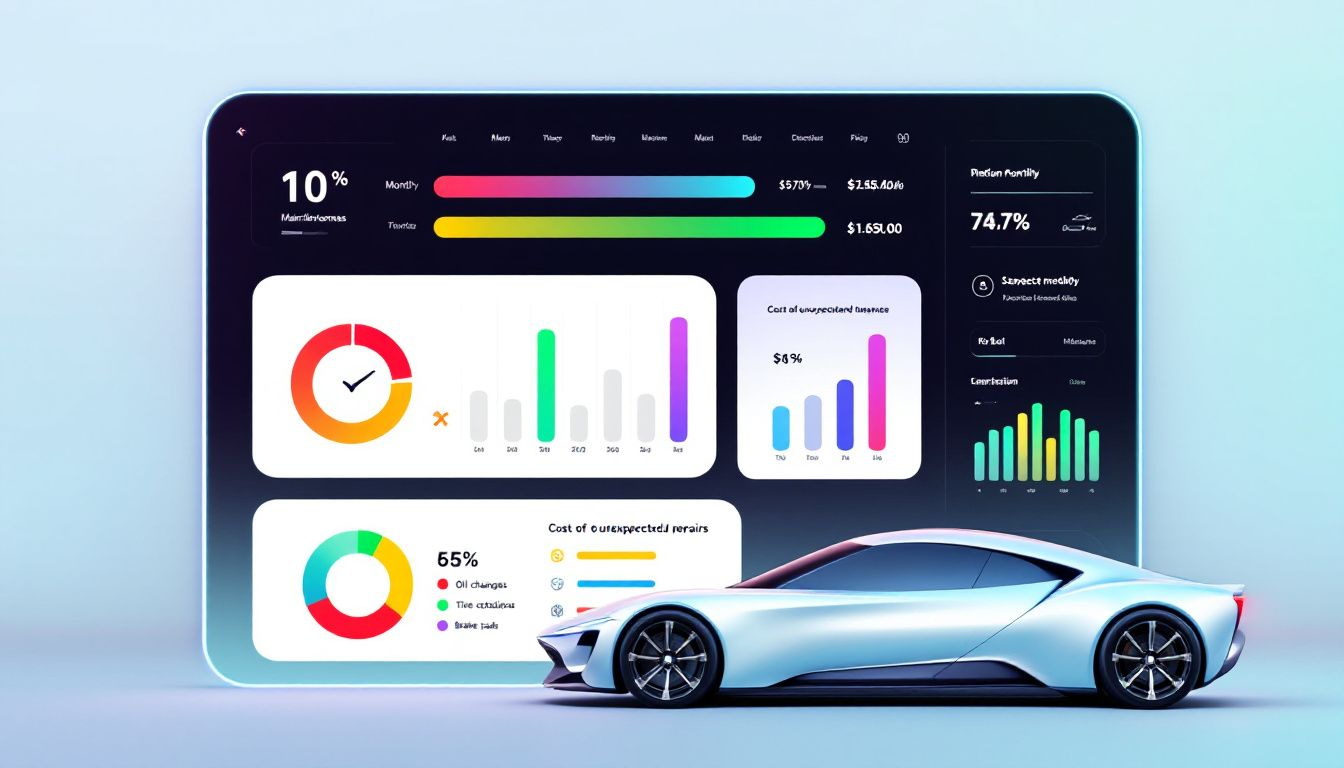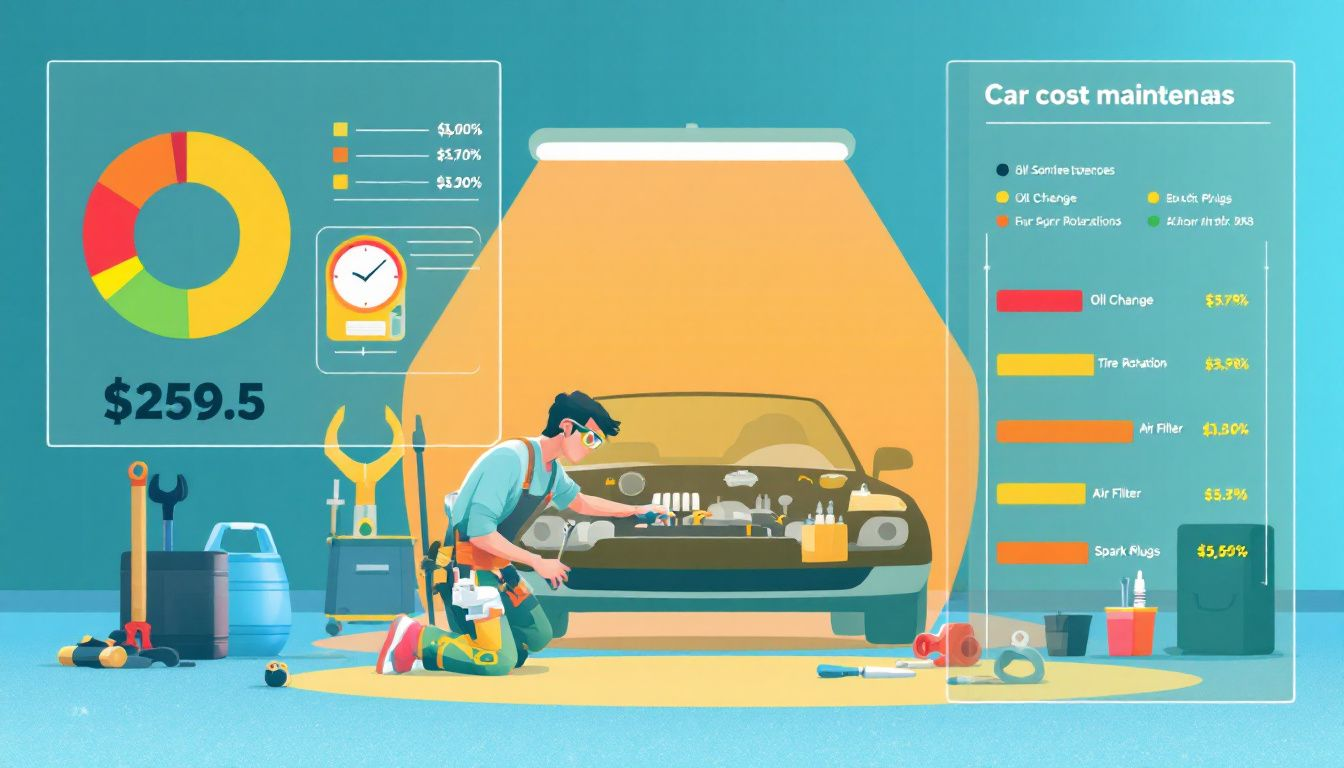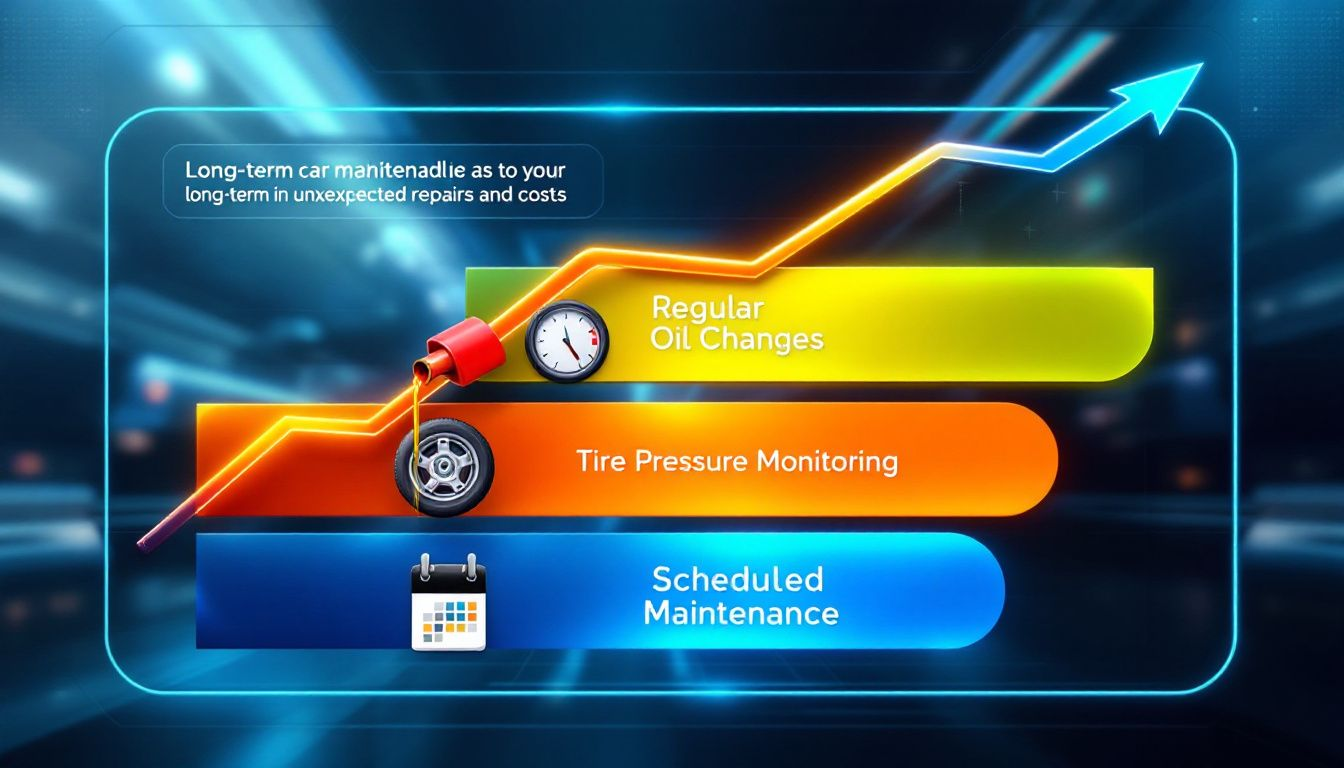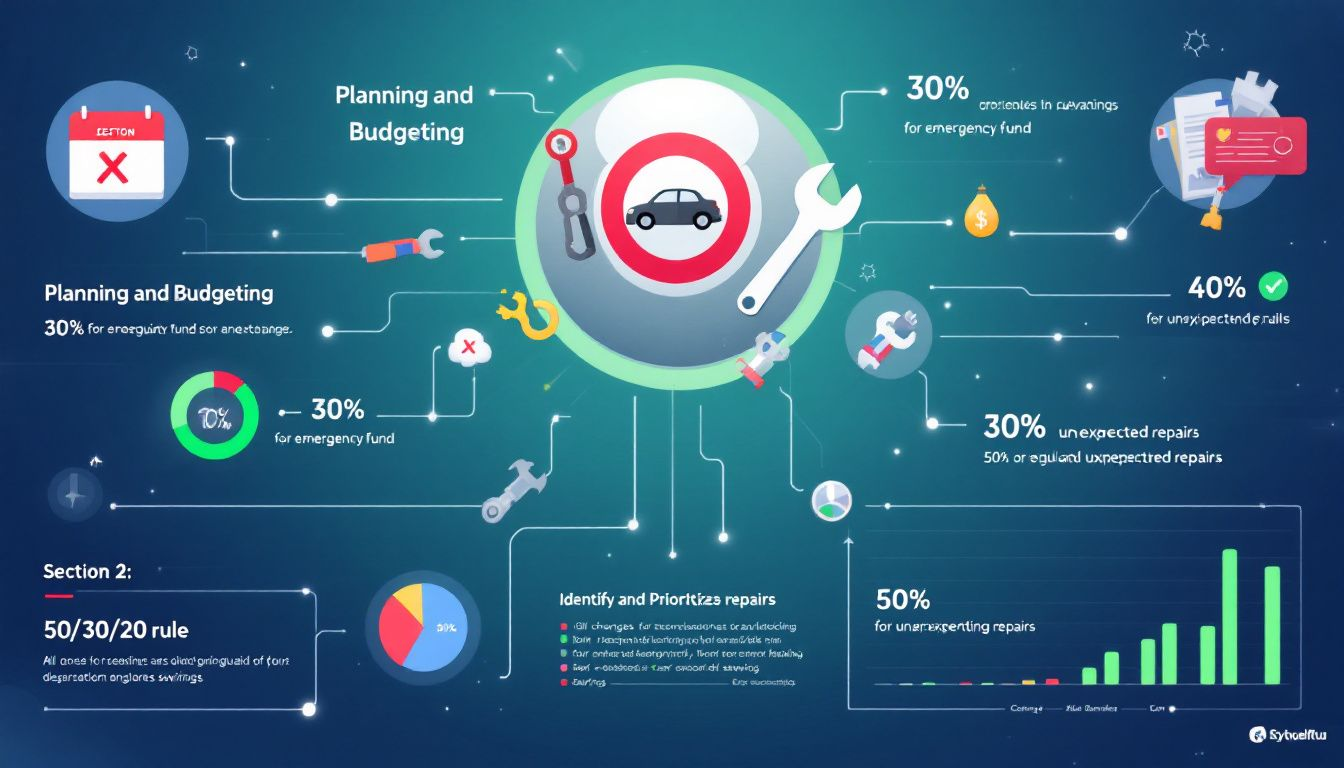How much should you budget for car maintenance? Typically, an annual budget of around $1,350 will cover both routine upkeep and unexpected repairs. In this guide, we’ll break down how much to budget for car maintenance costs of essential maintenance tasks like oil changes, tire rotations, and brake pad replacements. We’ll also share tips for effective financial planning, so you can keep your vehicle running smoothly without breaking the bank.
Key Takeaways
- Car maintenance costs vary based on vehicle age, type, and driving conditions, with older and luxury cars needing more frequent care.
- Setting aside about $112.50 monthly for routine maintenance and an additional $50 for unexpected repairs can help manage costs and prevent financial strain.
- Performing DIY maintenance, finding reliable mechanics, and using tools like the Carly app can significantly save on repair expenses.
Understanding Car Maintenance Costs

Car maintenance costs can seem mysterious, but several factors influence these expenses. Annual basic maintenance costs can range from a few hundred dollars depending on your vehicle’s needs. Older vehicles generally incur higher expenses than newer models due to increased repair needs, making this an important consideration when budgeting.
GAIN MORE CONTROL OF YOUR CAR WITH THE CARLY FEATURES
Check the exact pricing of Carly for your car brand!

Fast International Shipping with DHL

14 days adaptor return policy

Excellent customer support

Lifetime warranty in the hardware
SEEN IN
The type of car you drive also plays a significant role in maintenance costs. Luxury and performance cars often have elevated maintenance costs because of their specialized parts. Moreover, geographical location can influence these costs; for example, cars in colder regions often need more frequent battery and tire replacements. As your car ages and accumulates mileage, more maintenance is required, especially after hitting milestones like 50,000 miles.
Driving conditions also play a significant role. Vehicles in extreme environments experience quicker wear and tear, requiring more frequent maintenance. Choosing the right vehicle model can impact long-term maintenance expenses. Understanding these factors helps in better anticipating and budgeting for your car’s needs.
Oil Changes
Oil changes are a fundamental part of car maintenance, ensuring that your engine runs smoothly. The typical cost range for an oil change is between $30 to $150, depending on whether you use conventional or synthetic oil. Conventional oil changes usually cost between $35 to $75, while synthetic oil changes range from $65 to $125. European imports using synthetic oil can go up to 15,000 miles before needing an oil change, whereas most manufacturers advise oil changes every 3,000 to 5,000 miles, depending on the vehicle’s specifications.
Regular oil changes maintain engine performance and prevent costly repairs. Neglecting this task can lead to significant engine damage.
Refer to your car’s owner’s manual for specific oil change intervals and keep track to avoid unexpected repairs.
Tire Rotations
Tire rotations are another essential aspect of routine maintenance. They help maintain even tire wear, which enhances tire longevity and ensures safe driving. Tire rotations are recommended every 5,000 to 7,000 miles to maintain even wear and prevent issues like flat tires or reduced lifespan.
The cost of a tire rotation can vary significantly, influenced by the auto shop and the number of tires being rotated. Tire rotations, though an additional cost, are a cost-effective method to extend tire life and avoid premature replacements. Monitoring tire rotations can save money and ensure smooth vehicle operation.
Brake Pads
Brake pads are critical for your car’s safety and performance. They can last anywhere from 30,000 to 80,000 miles depending on various factors like driving behavior and conditions. Typically, brake pads require replacement between 25,000 and 65,000 miles. Driving in stop-and-go traffic can reduce their lifespan to around 35,000 miles.
The cost to replace brake pads ranges from $100 to $300 per axle, and for a complete brake job, which includes additional components, costs can go up to $1,000. Regular brake maintenance enhances safety and prevents expensive repairs. Keeping brakes in good condition is a wise investment in your vehicle’s health.
Budgeting for Routine Maintenance

Budgeting for routine car maintenance helps avoid unexpected financial strain. Establishing a clear budget based on factors like monthly income, car age, and driving frequency can manage costs more effectively. Staying informed about your vehicle’s needs and timelines aids in better financial planning.
Preparation for both expected and unexpected maintenance expenses is crucial. Setting aside at least $112.50 monthly for maintenance and repair costs can help avoid financial stress and keep your car in good condition.
Monthly Savings Plan
Creating a monthly savings plan is a practical way to budget for car maintenance. AAA suggests setting aside about $112.50 each month for routine car maintenance based on average driving mileage. It’s also wise to budget an additional $50 monthly for unexpected car repairs.
Consistently saving these amounts ensures financial preparedness for both routine and unexpected repairs. This strategy helps save money and reduces financial stress, allowing you to enjoy your car without constant worry.
Using Last Year’s Expenses
Reviewing last year’s maintenance expenses offers valuable insights into future costs. Analyzing these expenses helps establish an effective budget that accounts for major repairs, allowing for more accurate estimation and planning.
Adjust your budget based on previous expenditures, considering any unexpected repairs that occurred. This approach helps you anticipate future expenses more accurately and ensures you are better prepared financially for maintaining your vehicle.
Planning for Unexpected Car Repairs
Unexpected car repairs can be a significant financial burden if unprepared. A survey found that 64 million drivers lack the means to cover unexpected repairs. Setting aside funds specifically for car repairs or considering car insurance can prevent financial strain during emergencies.
Budgeting at least $100 monthly for maintenance and unexpected repairs can help manage costs and avoid financial stress when unexpected attention is needed.
Emergency Fund
An emergency fund for car repairs is essential to cover unexpected car emergencies. AAA recommends saving about $50 monthly for unexpected repairs, aiming for an emergency fund that covers at least one to two major repair expenses.
Having an emergency fund relieves financial anxiety regarding car repairs. Replenishing it after use ensures funds are available for future emergencies.
Common Car Repairs
Common car repairs vary in expense. ‘Check engine’ repairs can range from $25 to $1,400. Car batteries generally cost between $45 to $250, while transmission replacements can range from $2,900 to $7,100.
Being prepared for these common issues can help you manage unexpected repair costs more effectively. Knowing what to expect and having an emergency fund can alleviate the financial burden of these repairs.
Saving Money on Car Maintenance

Saving money on car maintenance involves strategies and informed decisions. Utilizing basic DIY skills can significantly lower repair expenses. Additionally, finding reliable mechanics and using tools like Carly helps manage and reduce costs.
Incorporating these strategies helps maintain your vehicle’s health without breaking the bank. Here are some cost-saving methods in detail.
DIY Maintenance
Performing simple maintenance tasks at home can help save significant money on car repair costs. Changing oil at home can save between $25 to $75 per service compared to professional services. Changing air filters and regularly checking and refilling essential fluids, such as the windshield wiper fluid and radiator fluid, are manageable DIY tasks.
Car owners can perform these common maintenance tasks themselves, saving money and gaining a better understanding of their vehicle’s condition.
Finding Reliable Mechanics
Finding reliable mechanics is crucial for managing costs. Obtaining multiple quotes ensures competitive pricing and better service. Building a relationship with a local repair shop can lead to better deals and personalized service.
Checking customer reviews and testimonials helps identify trustworthy mechanics, saving you from overpaying and ensuring quality care for your vehicle.
Carly: Enter your car data and check upcoming repair costs
The Carly app provides significant savings on maintenance by offering diagnostic tools and repair instructions tailored to specific car models, making DIY repairs more manageable.
The app provides early warnings for potential issues, potentially saving users from expensive repairs by addressing problems sooner. Carly also helps reset service intervals and register new batteries, reducing reliance on workshops for routine car management.
Long-Term Car Maintenance Strategies

Long-term maintenance strategies can significantly reduce costs and enhance vehicle longevity. Frequent maintenance identifies and resolves issues early, preventing costly repairs. Tasks like oil changes and tire rotations are essential.
Let’s explore some specific strategies to help you maintain your car effectively over the long term.
Regular Inspections
Regular inspections are essential for maintaining vehicle health and extending its lifespan. Routine inspections can help identify issues early, preventing potentially expensive repairs. Full inspections often uncover problems that basic checks might miss, allowing for timely intervention.
Incorporating regular inspections into your maintenance routine helps avoid larger repairs and keeps your vehicle running smoothly.
Proper Driving Habits
Smooth driving techniques reduce strain on the vehicle’s components, extending their life. Gentle acceleration and braking, along with maintaining a consistent speed, can minimize engine wear and enhance fuel efficiency.
By adopting driving habits that reduce wear and tear on the vehicle, you can significantly lower maintenance costs over time.
How to Pay for Car Repairs

Paying for car repairs can be challenging without financial preparation. AAA advises saving $100 monthly for maintenance and repairs. Once the car is paid off, shifting the amount used for car payments into savings for larger repairs can significantly alleviate financial burden.
Establishing a budget for car repairs avoids financial stress. Planning ahead and setting aside funds helps manage maintenance costs and keep your vehicle in good condition.
Sinking Fund
A sinking fund is a practical way to manage large maintenance expenses. Setting aside a predetermined monthly amount for future car expenses ensures funds are available when needed.
Estimating yearly repair costs helps determine how much to allocate monthly to a sinking fund. This method allows gradual saving and preparedness for significant repair costs.
Using Credit Wisely
Using credit responsibly can provide a safety net for car repairs with a clear car payment plan. Establishing this plan is essential to avoid accruing debt.
A 0% APR credit card allows financing repairs without interest if paid off within the promotional period, helping manage costs without adding financial stress.
Summary
Budgeting for car maintenance is crucial to avoid unexpected financial strain and ensure your vehicle stays in top condition. By understanding the factors that influence maintenance costs and creating a monthly savings plan, you can be better prepared for both routine maintenance and unexpected repairs. Planning for these expenses not only helps you save money but also reduces financial stress.
Incorporating DIY maintenance tasks, finding reliable mechanics, and using tools like Carly can further help manage and reduce maintenance costs. Implementing long-term strategies, such as regular inspections and proper driving habits, can significantly lower maintenance expenses over time.
Taking control of your car maintenance budget will allow you to enjoy the freedom of driving without the constant worry of unexpected repair costs. By being proactive and prepared, you can keep your vehicle running smoothly and your wallet intact.
Frequently Asked Questions
How much should I budget monthly for car maintenance?
To stay on top of car maintenance, budgeting around $162.50 each month should cover both routine checks and unexpected repairs. It’s a smart way to keep your car in great shape without breaking the bank!
What are some common car repairs I should be prepared for?
Be prepared for common car repairs like oil changes, tire rotations, brake pad replacements, and ‘check engine’ issues, as they can vary in cost but are essential for keeping your car running smoothly. Regular maintenance can help you avoid bigger expenses down the line!
How can I save money on car maintenance?
You can save money on car maintenance by handling simple tasks yourself and choosing trustworthy mechanics. Using handy apps like Carly can also help you keep track of your car’s needs and avoid unnecessary expenses.
What is an emergency fund for car repairs?
An emergency fund for car repairs is a savings account dedicated to covering unexpected car expenses, ideally funded with about $50 each month. This way, you won’t be caught off guard when those surprise repairs pop up!
How can I use credit responsibly for car repairs?
To use credit responsibly for car repairs, consider a 0% APR credit card and create a solid repayment plan to avoid accumulating debt. Just make sure to pay off the balance before the promotional period ends!

